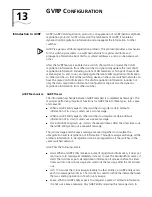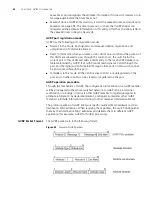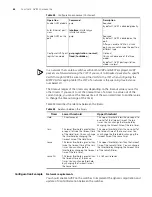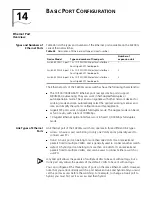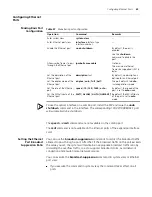
Configuring Ethernet Ports
71
Configuring Trunk Port
Attribute
Copying Port
Configuration to Other
Ports
To keep the configuration of some other ports consistent with a specified port, you
can copy the configuration of the specified port to these ports.
The configuration may include:
■
VLAN settings: Includes the permitted VLAN types and default VLAN ID.
■
LACP settings: LACP enabled/disabled.
■
QoS settings: Includes traffic limiting, priority marking, default 802.1p priority,
bandwidth reservation, congestion avoidance, traffic direction, and traffic
statistics.,
■
STP settings: Includes STP enabling/disabling, link attribute (point-to-point or not),
STP priority, path cost, maximum transmission speed, loop protection, root
protection, and edge port or not.
■
Port setting: Includes port link type, port speed, and duplex mode.
If you specify the source aggregation group ID, the system uses the port with the
smallest port number in the aggregation group as the source.
If you specify the destination aggregation ID, the configuration of the source port will
be copied to all ports in the aggregation group.
Add the current hybrid
port into the specified
VLAN
port hybrid
vlan
vlan-id-list
{
tagged
|
untagged
}
Optional
For a hybrid port, you can
configure to tag the packets
of specific VLANs, based on
which the packets of those
VLANs can be processed in
differently ways.
Table 51
Configure hybrid port attribute
Table 52
Configure trunk port attribute
Operation
Command
Remarks
Enter system view
System-view
—
Enter Ethernet port view
interface
interface-type
interface-number
—
Set the link type for the port
as trunk
port link-type
trunk
Required
Set the default VLAN ID for
the trunk port
port trunk pvid vlan
vlan-id
Optional
By default, the VLAN of a trunk
port is VLAN 1.
Add the current trunk port
into the specified VLAN
port trunk permit vlan
{
vlan-id-list
|
all
}
Optional
Table 53
Copy port configuration to other ports
Operation
Command
Remarks
Enter system view
system-view
—
Copy port
configuration to other
ports
copy configuration source
{
interface-type
interface-number
|
aggregation-group
source-agg-id
}
destination
{
interface-list
[
aggregation-group
destination-agg-id
] |
aggregation-group
destination-agg-id
}
Optional
Summary of Contents for 4200G 12-Port
Page 10: ...8 CONTENTS...
Page 14: ...4 ABOUT THIS GUIDE...
Page 46: ...32 CHAPTER 5 LOGGING IN THROUGH WEB BASED NETWORK MANAGEMENT SYSTEM...
Page 48: ...34 CHAPTER 6 LOGGING IN THROUGH NMS...
Page 60: ...46 CHAPTER 9 VLAN CONFIGURATION...
Page 64: ...50 CHAPTER 10 MANAGEMENT VLAN CONFIGURATION...
Page 80: ...66 CHAPTER 13 GVRP CONFIGURATION...
Page 98: ...84 CHAPTER 15 LINK AGGREGATION CONFIGURATION...
Page 112: ...98 CHAPTER 18 MAC ADDRESS TABLE MANAGEMENT...
Page 126: ...112 CHAPTER 19 LOGGING IN THROUGH TELNET...
Page 162: ...148 CHAPTER 20 MSTP CONFIGURATION...
Page 274: ...260 CHAPTER 29 IGMP SNOOPING CONFIGURATION...
Page 276: ...262 CHAPTER 30 ROUTING PORT JOIN TO MULTICAST GROUP CONFIGURATION...
Page 298: ...284 CHAPTER 33 SNMP CONFIGURATION...
Page 304: ...290 CHAPTER 34 RMON CONFIGURATION...
Page 338: ...324 CHAPTER 36 SSH TERMINAL SERVICES...
Page 356: ...342 CHAPTER 38 FTP AND TFTP CONFIGURATION...
Page 365: ...Information Center Configuration Example 351 S4200G terminal logging...
Page 366: ...352 CHAPTER 39 INFORMATION CENTER...
Page 378: ...364 CHAPTER 40 BOOTROM AND HOST SOFTWARE LOADING...
Page 384: ...370 CHAPTER 41 Basic System Configuration and Debugging...
Page 388: ...374 CHAPTER 43 NETWORK CONNECTIVITY TEST...
Page 406: ...392 CHAPTER 45 CONFIGURATION OF NEWLY ADDED CLUSTER FUNCTIONS...





